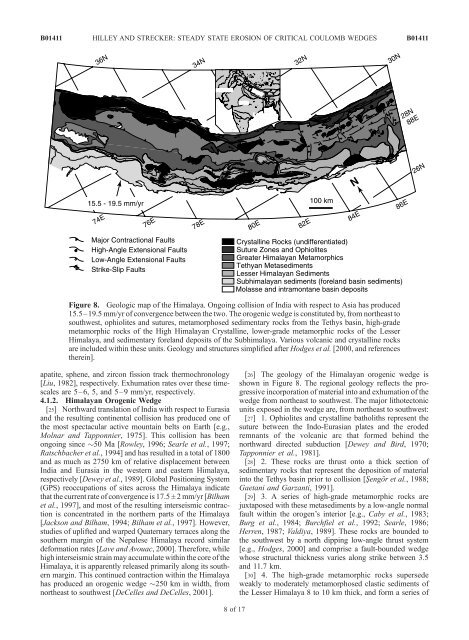Steady state erosion of critical Coulomb wedges with applications to ...
Steady state erosion of critical Coulomb wedges with applications to ...
Steady state erosion of critical Coulomb wedges with applications to ...
You also want an ePaper? Increase the reach of your titles
YUMPU automatically turns print PDFs into web optimized ePapers that Google loves.
B01411 HILLEY AND STRECKER: STEADY STATE EROSION OF CRITICAL COULOMB WEDGES<br />
Figure 8. Geologic map <strong>of</strong> the Himalaya. Ongoing collision <strong>of</strong> India <strong>with</strong> respect <strong>to</strong> Asia has produced<br />
15.5–19.5 mm/yr <strong>of</strong> convergence between the two. The orogenic wedge is constituted by, from northeast <strong>to</strong><br />
southwest, ophiolites and sutures, metamorphosed sedimentary rocks from the Tethys basin, high-grade<br />
metamorphic rocks <strong>of</strong> the High Himalayan Crystalline, lower-grade metamorphic rocks <strong>of</strong> the Lesser<br />
Himalaya, and sedimentary foreland deposits <strong>of</strong> the Subhimalaya. Various volcanic and crystalline rocks<br />
are included <strong>with</strong>in these units. Geology and structures simplified after Hodges et al. [2000, and references<br />
therein].<br />
apatite, sphene, and zircon fission track thermochronology<br />
[Liu, 1982], respectively. Exhumation rates over these timescales<br />
are 5–6, 5, and 5–9 mm/yr, respectively.<br />
4.1.2. Himalayan Orogenic Wedge<br />
[25] Northward translation <strong>of</strong> India <strong>with</strong> respect <strong>to</strong> Eurasia<br />
and the resulting continental collision has produced one <strong>of</strong><br />
the most spectacular active mountain belts on Earth [e.g.,<br />
Molnar and Tapponnier, 1975]. This collision has been<br />
ongoing since 50 Ma [Rowley, 1996; Searle et al., 1997;<br />
Ratschbacher et al., 1994] and has resulted in a <strong>to</strong>tal <strong>of</strong> 1800<br />
and as much as 2750 km <strong>of</strong> relative displacement between<br />
India and Eurasia in the western and eastern Himalaya,<br />
respectively [Dewey et al., 1989]. Global Positioning System<br />
(GPS) reoccupations <strong>of</strong> sites across the Himalaya indicate<br />
that the current rate <strong>of</strong> convergence is 17.5 ± 2 mm/yr [Bilham<br />
et al., 1997], and most <strong>of</strong> the resulting interseismic contraction<br />
is concentrated in the northern parts <strong>of</strong> the Himalaya<br />
[Jackson and Bilham, 1994; Bilham et al., 1997]. However,<br />
studies <strong>of</strong> uplifted and warped Quaternary terraces along the<br />
southern margin <strong>of</strong> the Nepalese Himalaya record similar<br />
deformation rates [Lave and Avouac, 2000]. Therefore, while<br />
high interseismic strain may accumulate <strong>with</strong>in the core <strong>of</strong> the<br />
Himalaya, it is apparently released primarily along its southern<br />
margin. This continued contraction <strong>with</strong>in the Himalaya<br />
has produced an orogenic wedge 250 km in width, from<br />
northeast <strong>to</strong> southwest [DeCelles and DeCelles, 2001].<br />
8<strong>of</strong>17<br />
B01411<br />
[26] The geology <strong>of</strong> the Himalayan orogenic wedge is<br />
shown in Figure 8. The regional geology reflects the progressive<br />
incorporation <strong>of</strong> material in<strong>to</strong> and exhumation <strong>of</strong> the<br />
wedge from northeast <strong>to</strong> southwest. The major lithotec<strong>to</strong>nic<br />
units exposed in the wedge are, from northeast <strong>to</strong> southwest:<br />
[27] 1. Ophiolites and crystalline batholiths represent the<br />
suture between the Indo-Eurasian plates and the eroded<br />
remnants <strong>of</strong> the volcanic arc that formed behind the<br />
northward directed subduction [Dewey and Bird, 1970;<br />
Tapponnier et al., 1981].<br />
[28] 2. These rocks are thrust on<strong>to</strong> a thick section <strong>of</strong><br />
sedimentary rocks that represent the deposition <strong>of</strong> material<br />
in<strong>to</strong> the Tethys basin prior <strong>to</strong> collision [S¸engör et al., 1988;<br />
Gaetani and Garzanti, 1991].<br />
[29] 3. A series <strong>of</strong> high-grade metamorphic rocks are<br />
juxtaposed <strong>with</strong> these metasediments by a low-angle normal<br />
fault <strong>with</strong>in the orogen’s interior [e.g., Caby et al., 1983;<br />
Burg et al., 1984; Burchfiel et al., 1992; Searle, 1986;<br />
Herren, 1987; Valdiya, 1989]. These rocks are bounded <strong>to</strong><br />
the southwest by a north dipping low-angle thrust system<br />
[e.g., Hodges, 2000] and comprise a fault-bounded wedge<br />
whose structural thickness varies along strike between 3.5<br />
and 11.7 km.<br />
[30] 4. The high-grade metamorphic rocks supersede<br />
weakly <strong>to</strong> moderately metamorphosed clastic sediments <strong>of</strong><br />
the Lesser Himalaya 8 <strong>to</strong> 10 km thick, and form a series <strong>of</strong>
















